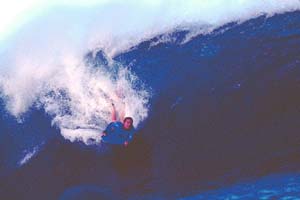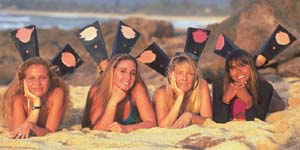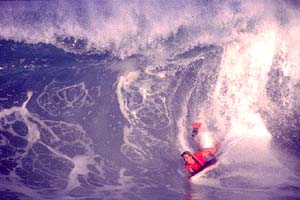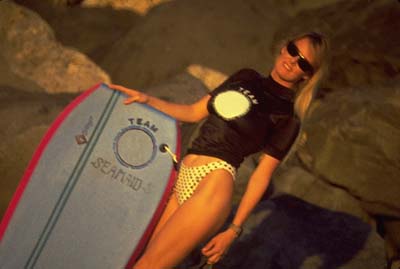Pioneer Carol Philips is a true pioneer on the North Shore, being one of the first woman bodyboarders to challenge the big stuff. But Carol has gone beyond that, promoting the sport for both men and women. This interview was done at Ehukai Beach Park on December 13, 1997, just after we had gotten in from a fun session at Pipeline. HSA: How long have you been bodyboarding or surfing? CP: I've been bodyboarding about 14 years. HSA: Through that time, have you been bodyboarding the North Shore? Were you born and raised on the North Shore? CP: Actually, I was born in California, and moved to Hawaii when I was three. And I started coming out to the North Shore when I was 14. Then I started bodyboarding when I was almost 18. I've travelled a lot since then, but I'm definitely a North Shore girl. HSA: Weren't you the one who started the first women's bodyboarding contest here at Pipeline? CP: Yes, it was back in 1989. I had no idea what I was doing. I mean I didn't know that Pipeline was PIPELINE, and that there was all this hype. And I didn't really know how important it was that we were getting the women out there. Over the years, it really has been a wonderful and important thing for women in sports, in general.
 Carol at Pipeline John Bilderback photo HSA: Yeah. I think women's bodyboarding has pretty much blossomed ever since you started that first contest. As far as competition, we known that the Brazilian bodyboarding women have really dominated. But I think you've been the only one who's consistently given them competition. What's your take on that? CP: Actually there are some other women that are coming up and starting to give them a rub. Robin Cardoza's name comes up to mind, and there's a couple of other girls that are getting better. The Brazilian girls have a definite advantage, though, for a couple of reasons. One, there are so many of them, and when you have a larger pool of people, you're gonna have the talent and the people are going to rise to the top. The other thing is they get better sponsors, and they are able to be professionals, whereas for the Americans, there is no American girl who doesn't have to work to pay her way. It really, really makes a difference if you can be a pure professional and surf and train and live only for bodyboarding, instead of having to "have a job" and "work"! Oooh, swear words!
 Viper Girls: Guinnevere Allen, Jenn Marr, Carol Philips, Robin Cardoza Brian Bielmann photo HSA: [laugh] OK, about the sponsorship issue--in the surfing industry, I've noticed that there's a big boom in women's surfing. Has that popularity also gone across into the bodyboarding field? CP: It's starting to transcend into it. It's been a little frustrating because our level of performance has been so much higher than the women surfers. But because the whole surf industry is controlled by surfers, they started pushing their women surfers. But it's starting to come over to us and we're really excited about that. And I think it's only going to get better as time goes on. HSA: Let's talk a little bit more about yourself. Hmmm.... How's V-Land? (Velzyland, Carol's home break) CP: [Jokingly] There's this dead cow, and it's sunk on the reef at V-Land, and it's been there the last two years, and it attracts all these sharks. Nobody surf's there anymore, the water's all brown and murky, and it's just not like it used to be. HSA: OK... [big laughs]. What about this new contest series? You're going to do a series of contests on the North Shore, not just for women bodyboarding, but for other disciplines of bodyboarding. Tell me a little bit about that. CP: It's called the Extreme Bodyboard Series, and the whole idea is to give bodyboarding a facelift; a more exciting image. We're trying to get away from that grovel type of image that a lot of competitions have promoted because of the lack of good venues. And also, we're being real basic about our marketing--it's simply extreme bodyboarding. We want people to understand that bodyboarding is extreme, so we're going to put that out there. The series is three events, at three venues. The first is at Waimea shorebreak, and it's an invitational for guys. We don't want to kill any of the girls. I've been out there when it was sizeable, doing my recon mission, and I decided that it really wasn't appropriate for the women to go out at this time. But it's 24 guys, and we're all real excited about it. It'll be held in 6-8' shorebreak, and this is the catcher--unfortunately right now, we only have a one week holding period. So if we don't get the conditions, we're not going to run it. We're going to run it only in extreme Waimea shorebreak so that we do the sport justice... HSA: That's good. Kinda like the Quiksilver (Eddie Aikau) thing where you wait for a certain wave criteria. CP: Exactly, exactly. We don't want to sell it short; we'd rather not have an image out there than have a bad image. It'll really be good for the sport no matter what happens since it'll show our commitment to good conditions. HSA: And the other events... CP: The second event is the 9th Annual Women's World Championship of Bodyboarding, our crown event. That's going to be 64 women competitors from around the world. We're going to also be including, which we did last year, a dropknee expression session. This is really exciting too because Jack Lindholm was the first to bodyboard at Pipe, and he did it dropknee. And so, it's something that's kind of long overdue. And the dropknee riders are so wonderful anyway. You got guys like Kainoa McGee just killing it out there, in fact he won it last year. So what I did this year was beg and grovel to the powers that be to get the event expanded to two semis and a final. That's really exiting for us since there's so many competitors that want to get in there, and we're really pleased to offer them this venue and push an alternative image to bodyboarding. Then the third event is at Velzyland -- the dead cow on the reef venue with the sharks [grin]. That's going to be a women's event, 32 women. Included in that, we're going to have a standup expression session. And again, we're really excited about this because it's showing the sport as having more culture, more style, and not just being one particular thing. You have people like Chris Won and Cavin Yap and Danny Kim, setting standards and blowing people's minds and helping to gain respect for bodyboarding, and yet there are no competition venues for them. So the whole thing in a nutshell is actually five events, when you count the contests within the contests. We're just taking bodyboarding to a new level and it's really wonderful. HSA: I think it's a great idea; awesome. OK, let's get back to you. Phyliss Dameron was the first bodyboarding woman who got any recognition (surfing Waimea Bay), but... you've been, pretty much, the only one who's been riding the North Shore that I've seen and recognized, up until recently. And you charge! Where'd you get the balls to do that? [jokingly] CP: [chuckle] Actually, it's not balls, it's boobs. We get our mana from another place... nah, only kidding. You know what? The truth is, years ago, I used to go out with this bodyboarder who rode big waves, and he introduced the sport to me as a big wave sport. I was bodyboarding for like two months, and then he took me out to eight foot Pipeline. Now, I want to go on the record as saying that I don't think that this is a good way to go. And the fact that I lived has a lot to do with the kind of person I am. I trained in martial arts and I have a little more self-control and endurance. I knew about mind control and not to panic and all that kind of stuff, and somehow I lived. I think that it was a bizzare mixture of being at the right place at the right time with the right attitude. And in the early days, it was a lot less crowded, so it was a little safer too. And I've always been the kind of person where the skies the limit, just do it. I have limits, though, on the other hand. I was out at Waimea, years ago, and it closed out... HSA: Omigod! CP: ... and somehow I made it over the top of the wave. I remember it was so big, I like freefell down the back of the wave, and looked back and saw the whitewater, like when a shorebreak closes and it sucks and pulls like a claw, well the whole bay was like that. So I looked back and I saw this whole thing shutting down behind me, and I started doing the math, but the math was not there because if I had to take off on a wave like that and straighten out... I couldn't do it. Well, we know from my wipeout at Pipeline that I'm not good at straightening out anyway; now imagine a wave that is five times as big as that. And it was like, I wanted my mother; I was scared. It really woke me up, because I'm not out there to prove anything or to die or anything like that--I do it for fun. It's a hobby. So it kinda toned me down a bit. I'll still go out in like 18-20 feet, but I'm really a lot more cautious about it: I make sure I know what the swell is doing, whether it's coming up or going down... I want to live. Even up to 15 feet, I'm really comfortable...
 Carol pulling in at Ke Iki shorebreak Greg Hugland photo HSA: Whew, it just blows my mind the size you ride. I guess it's all relative. CP: Well, you were pulling into some pretty big Backdoor waves today yourself. HSA: No, not no 15 footers, though... CP: Well I wouldn't pull into any 15 foot Backdoor myself. But when you live on the North Shore, that's what's surfing's about. It's not about one-to-two foot Huntington or Turtle Bay; it's about 8-10' Pipeline or bigger. If you live out here and you're into the sport, you sure as heck better go out and ride it otherwise you're just a poser. I appreciate people who love the sport and don't participate in it fully and have different limitations and stuff like that. And I think it's neat and nice that people are into it, but I gotta go out and catch those [big] waves. HSA: I kinda know the feeling, but on a smaller scale. So, you were pretty much a loner out there bodyboarding. Did you have to deal with a lot of bad attitude out here, or did they accept you? CP: I'll have to go on record as saying that all these guys are the nicest, most wonderful guys I've ever met. They are totally respectful, encouraging... They're all like my best friends; they're like family, you know? It's funny, because you hear stories about women in other places who are told "go in" or "you belong in the kitchen" and they're not even surfing extreme waves. Over here, it's like, I've never got anything like that; they're so nice to me and help me out. It's interesting because you are on the North Shore and it is the pinnacle, I suppose, of the surfing world. And the guys out here are totally cool--they're not macho guys, they're nice. And another thing you'll notice is that bodyboarding and surfing, they get along beautifully on the North Shore. It's a bit of a phenomenon because it doesn't happen like that everywhere in the world... HSA: Unless it's in cold climates, but anywhere else, especially in SoCal, it's terrible. CP: It is. But on the North Shore I think you have a different class of people and what it is is that we're all surfers... we're all surfers and everyone is respected regardless of how they got out there. As long as they're somewhat competent and respectful to everybody else, they're respected. And it's not, "go in you're a sponger." I've never seen a sponger sent in from Waimea, for example, because it's too heavy a situation. Just to be out there, you're given respect. I think it can give our sport, and the whole surfing sport, a lotta hope, because really, what's going on on the North Shore dictates what's really going on in the spirit, in the soul of surfing. And I think we're lucky because it is real--the whole thing is real. All the posing images and all the negative vibes that you get in California against bodyboarders. That's just a bunch of immature, egotistical, insecure people. I tell you, I've learned with the best waveriders in the world and they've never said "go in and cook"... well I can't cook! But they never said anything bad, because it's all about riding waves. Everyone over here is so confident, they know what they're doing, they're not worried about it. You go to other places and people put down bodyboarders because they are insecure about what they are doing; or they are out there for the wrong reasons, and they are trying to be cool and imaging. About here it's not like that--it's about riding waves, it's about survival. And everybody out there has to help each other out, it's an ohana, it really is. HSA: Really good words. Well... since you brought up that straightening out at Pipe incident... you knew I was going to ask you about this. That was one of the most spectacular wipeouts I have ever seen (on video). You actually got clipped by the lip as you straightened out, and it bounced you up, then you got picked up again and was again thrown out of the water. Tell us what happened. I know that for you it wasn't that big a deal, but for the rest of us mortals, wow! CP: What happened was just what you said. I was straightening out on the wave, because it was closing out. It was one of those days when you couldn't get a lot of waves, and you want a wave. I don't know what happened. The lip like hit me, and blasted me in the air. And then it somehow sucked me back over the falls, and then tossed me out again. And, I was in the air most of the time so I didn't get hurt, I didn't hit the bottom or anything. I did go to my chiropractor the next day--get my neck fixed a little bit. But, I remember my leash came off, and my board popped up right next to me. I'm all, well this will freak them out. I'll just paddle back out as if nothing else happened. HSA: I saw that on video. You just paddled right back out. CP: I was pretty shooken up after that, and I sat out there for 20 minutes before I caught a wave in. I remember telling Mike (Stewart) and Chris (Won), "Omigod, you guys, you've no idea; that was the heaviest wipeout, you don't even know, omigod it was so freakin'." They were like, "yeah, yeah, yeah." It kinda scared me. But the bottom line is, always pull in, especially if you are not going to make the straightening out. It's a lot safer in the tube. The lip is so powerful as far as metric tonnage--I'm lucky I didn't get hurt. HSA: That's about it. Do you have anything else you want to say to the surfing world, any words of wisdom that you would like to pass along? CP: I think that, in general, bodysurfing, bodyboarding and surfing are getting more popular and are becoming mainstream sports. And I think we all really do need to get together and be more unified and develop a really healthy platform for the sports in general. And when I'm talk about a healthy platform, I'm talking about AIDS awareness, environmental issues, social issues. Get along, cause we have a certain amount of power with the media. Protecting children, child abuse, stuff like that. And we can use the influence we have with the media to help increase social awareness of these real problems. So we need to get united, the whole surfing community should get together and develop a solid platform to actually do something to make the world better so that we can enjoy the ocean longer and our children can enjoy the ocean, and we can all live. Addresses Extreme Bodyboard Series Press Release Association of Women Bodyboarders website H3O story on X-Press World Championship of Women Bodyboarding 1997 HI Surf Advisory: Shorebreaks of Oahu HI Surf Advisory: Session at Pipe with Carol |
